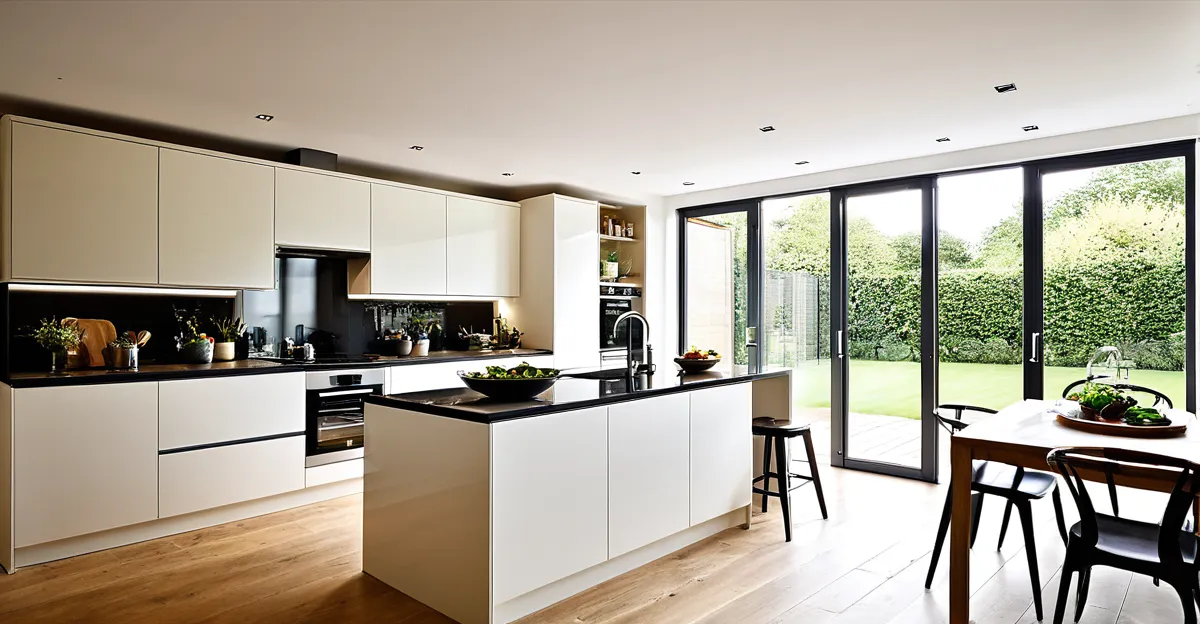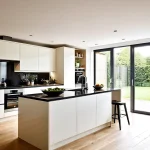Essential Space-Saving Strategies for Compact UK Kitchens
Maximising every inch is crucial in compact kitchen design. One effective strategy is utilising vertical space. Installing tall cabinets or shelves up to the ceiling creates extra storage without cluttering the floor. Incorporating hooks or magnetic strips for utensils also frees up counter space, making the kitchen look spacious and organised.
Choosing multi-functional furniture and fittings amplifies usability. For example, a kitchen island with built-in storage or a foldable dining table can double as prep space and dining area. Pull-out cutting boards or integrated bins within cabinets save crucial room and maintain a sleek look, ideal for a small kitchen layout.
Topic to read : Exploring the impact of space-saving furniture in compact uk kitchens
Streamlining layout enhances both movement and efficiency. A classic yet effective approach is the “work triangle” design, positioning the stove, sink, and fridge optimally. Narrow galley kitchens can benefit from this principle by ensuring clear pathways and enough counter space between key work areas. In UK kitchen space-saving scenarios, custom cabinetry tailored to fit awkward corners also reduces wasted space.
These practical strategies address space constraints, transforming compact kitchens into functional, enjoyable culinary environments without overwhelming the senses or budget.
Also to read : Maximizing cooking efficiency: the impact of kitchen layout in compact uk spaces
Optimising Storage and Organisation
Optimising kitchen organisation is essential, especially in tight spaces. One effective approach involves incorporating custom cabinetry tailored to your kitchen’s unique layout. These bespoke solutions often include pull-out shelves or drawers, allowing easier access and better use of space. Custom cabinetry also maximises vertical storage, one of the most under-utilised areas.
Corners and spaces above appliances typically remain wasted. Installing corner carousel units or retractable shelves transforms these awkward spots into valuable storage, vastly improving small kitchen storage solutions. Additionally, placing sturdy shelves above ovens or fridges provides convenient spots for infrequently used items.
Implementing organiser tools inside drawers and cupboards keeps utensils, spices, and cookware neatly separated. Dividers, spice racks, or tiered baskets not only prevent clutter but also speed up meal prep by keeping essentials visible and easy to grab.
Combining these strategies—custom cabinetry, creative corner usage, and effective organisers—forms the backbone of smart kitchen organisation. By carefully applying these declutter techniques, you enhance both functionality and aesthetics, making cooking and cleaning less stressful and more enjoyable.
Key Design and Layout Recommendations Tailored for UK Homes
Creating efficient UK kitchen layout ideas requires careful consideration of space and usability, especially in compact home kitchens. In many UK homes, kitchens tend to be smaller, demanding an ergonomic kitchen design that maximizes every inch while maintaining comfort.
For small spaces, adapting galley, L-shaped, and single-wall layouts is essential. These layouts support streamlined movement and effective use of space. Galley kitchens, common in UK flats, allow easy zoning of preparation, cooking, and storage by placing counters opposite each other. L-shaped kitchens create open areas that enhance accessibility and workflow, ideal for compact home kitchens. Single-wall layouts, though limited in space, can be customized with vertical storage solutions to increase capacity.
Focusing on zoning areas is crucial to improve kitchen ergonomics. Grouping preparation counters near sinks and cooking appliances reduces unnecessary movement, benefiting narrow kitchens prevalent in UK homes. Thoughtful layout design ensures that storage is within easy reach, supporting both efficiency and safety.
In summary, applying these UK kitchen layout ideas fosters a practical, comfortable, and visually appealing space tailored for the distinct needs of compact home kitchens.
Appliance and Fixture Choices for Functionality and Aesthetics
Selecting the right appliances and fixtures is crucial when designing a functional and visually appealing kitchen. In the UK, small kitchen appliances must maximize space without compromising performance. Choosing integrated appliances helps achieve a seamless look while saving countertop area. For instance, built-in ovens and dishwashers fit flush with cabinetry, creating a cohesive style that enhances the room’s flow.
Slim, slimline kitchen technology such as compact microwaves or narrow fridge units suit smaller footprints perfectly. These appliances maintain functionality while preserving precious kitchen space. Space-efficient sinks and taps also play a significant role. Opting for compact, multi-purpose sink units with pull-out taps balances usability and design, especially in kitchens where every inch counts.
Energy-saving solutions are increasingly valuable. Appliances rated highly for energy efficiency not only reduce bills but also support sustainable living. From LED lighting integrated into units to eco-friendly taps that conserve water, these features combine functionality and aesthetics.
When blending appliances with décor, consider subtle colour coordination and minimalist designs to maintain a clean and cohesive appearance. Integrated appliances with matching cabinet fronts can virtually disappear, providing an elegant backdrop for kitchen activities without visual clutter.
Enhancing Light, Colour, and Visual Space in Compact Kitchens
Creating a sense of openness in a compact kitchen hinges on meticulous choices in kitchen lighting and colour. Light colours such as soft whites, pastel blues, or pale greys are excellent for space-enhancing colour schemes. These palettes reflect more light, which instantly brightens the space and creates an illusion of larger dimensions.
Incorporating both natural and artificial lighting effectively is crucial. Positioning kitchen elements near windows maximises daylight, a natural mood booster and space enhancer. Complement this with layered artificial lighting—for example, under-cabinet LEDs and recessed ceiling lights—to avoid shadows that make a kitchen feel cramped.
Reflective materials and glass surfaces further extend the visual depth. Glossy cabinet finishes bounce light around, while glass splashbacks add transparency without sacrificing practicality. Mirrors, when used strategically, can double the perceived size of a kitchen by reflecting light and views.
Together, these elements—thoughtful kitchen lighting, carefully chosen colour schemes, and reflective features—transform compact kitchens into inviting, airy environments where every inch feels open and accessible.
Real-Life Case Studies: Balanced and Beautiful Small Kitchens in the UK
Small kitchen renovations in the UK offer inspiring examples of how limited space can be transformed into both practical and visually pleasing environments. One common thread across UK small kitchen examples is the use of clever storage solutions paired with light, neutral colors that expand the sense of space. For instance, a homeowner in London maximized vertical storage by installing open shelving combined with deep drawers, creating easy access while maintaining a clean look.
Another UK small kitchen example involved replacing bulky appliances with compact, multi-functional units. This choice freed valuable countertop and floor space, demonstrating how practical kitchen design inspiration often centers on efficient components. The transformation story highlights the balance between aesthetics and utility, as the homeowner incorporated subtle lighting and reflective surfaces to enhance brightness.
Key lessons drawn from these kitchen transformation stories emphasize the importance of planning for each user’s habits. Customization—whether through adjustable shelving or tailored layouts—ensures long-term satisfaction. Homeowners aiming to leverage these success stories should focus on maximizing every inch with smart storage and thoughtful design choices. Such solutions underscore the potential found within the UK’s compact kitchen market, making these spaces not only functional but uniquely beautiful.



